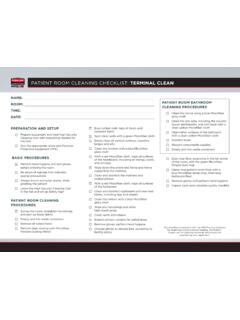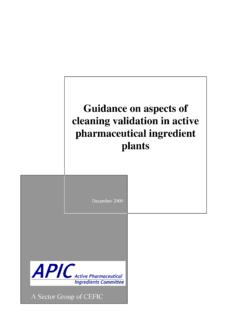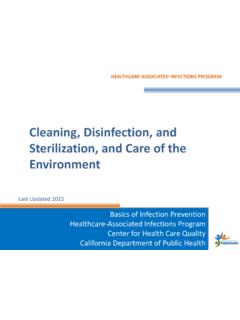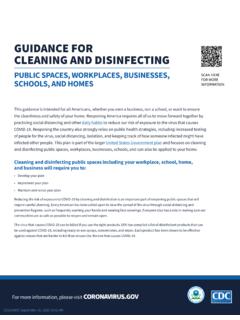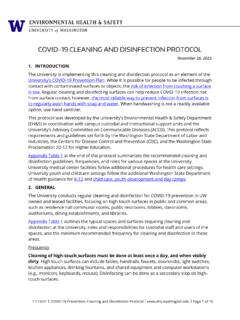Transcription of Unit 18: Cleaning, Decontamination and Waste Management
1 978 1 446 95316 7 Pearson BTEC Level 2 Diploma in Care (England) Unit Issue 1 January 2018 Pearson Education Limited 2018 1 Unit 18: cleaning , Decontamination and Waste Management Unit reference number: L/616/2954 Level: 2 Unit type: Optional Credit value: 2 Guided learning hours: 20 Unit summary The vulnerable health status of patients and users of care services means that it is crucial for practitioners to have a good understanding of how to keep a clean environment in order to reduce the spread of infection. By following the principles and steps of the Decontamination process, you will help maintain an effective workplace. In this unit, you will learn the correct way to maintain a clean environment in accordance with national policies. You will understand the procedures to follow when decontaminating an area from infection and be able to explain good practice when dealing with Waste materials.
2 You will also explore the importance of cleaning , Decontamination and Waste Management , for example hand-washing techniques, the use of personal protective equipment (PPE), cleaning schedules and the disposal of Waste materials. You will investigate relevant legislation and guidelines, and organisational policies. 978 1 446 95316 7 Pearson BTEC Level 2 Diploma in Care (England) Unit Issue 1 January 2018 Pearson Education Limited 2018 2 Learning outcomes and assessment criteria To pass this unit, the learner needs to demonstrate that they can meet all the learning outcomes for the unit. The assessment criteria outline the requirements the learner is expected to meet to achieve the unit. Learning outcomes Assessment criteria 1 Understand how to maintain a clean environment State the general principles for environmental cleaning Explain the purpose of cleaning schedules Describe how the correct Management of the environment minimises the spread of infection Explain the reason for the national policy for the colour coding of cleaning equipment 2 Understand the principles and steps of the Decontamination process Describe the three steps of the Decontamination process Describe how and when cleaning agents are used Describe how and when disinfecting agents are used Explain the role of personal protective equipment (PPE)
3 During the Decontamination process Explain the concept of risk in dealing with specific types of contamination Explain how the level of risk determines the type of agent that may be used to decontaminate Describe how equipment should be cleaned and stored 3 Understand the importance of good Waste Management practice Identify the different categories of Waste and the associated risks Explain how to dispose of the different types of Waste safely and without risk to others Explain how Waste should be stored prior to collection Identify the legal responsibilities in relation to Waste Management State how to reduce the risk of sharps injury 978 1 446 95316 7 Pearson BTEC Level 2 Diploma in Care (England) Unit Issue 1 January 2018 Pearson Education Limited 2018 3 Content What needs to be learned Learning outcome 1: Understand how to maintain a clean environment Maintaining a clean environment How to ensure good standards of environmental hygiene, including the need for correct hand hygiene.
4 Importance and value of cleaning schedules. Risks of non-compliance. Use of cleaning schedules. Application of national/organisational policies. Maintaining a clean environment by ensuring regular cleaning and inspection of all areas. All materials that require laundering, including uniform, are appropriately managed in order to minimise cross-contamination, including used linen, which has not been contaminated with blood or body fluids, contaminated linen, infectious linen, which has come into contact with known disease or infestation: Risks from visitors The five moments of hand hygiene. Provision of equipment and hand washing facilities. The national policy for the colour coding of cleaning equipment The code system and how it applies to areas and cleaning equipment. Checklists to ensure full compliance.
5 Reasons for monitoring and replacing equipment. Importance of colour identification testing: o red washroom floors, showers, sinks, toilets o blue offices and public areas o green kitchen/food and drink preparation areas o yellow hospital isolation areas. 978 1 446 95316 7 Pearson BTEC Level 2 Diploma in Care (England) Unit Issue 1 January 2018 Pearson Education Limited 2018 4 What needs to be learned Learning outcome 2: Understand the principles and steps of the Decontamination process Decontamination process Three steps of the Decontamination process: o cleaning , methods and frequencies o disinfection o sterilisation, including techniques. Use of cleaning agents Appropriate use of cleaning agents for objects and areas of low, medium and high risk. The concept of risk in dealing with specific types of contamination: o blood o vomit o faeces.
6 Use of disinfecting agents The link between the level of risk and the agent used. The use of disposable cloths/paper towels for drying. Hand care/hand hygiene. The role of personal protective equipment (PPE) in Decontamination Types of PPE, including how and when to use them, gloves, gowns, aprons. Role in protection of user from: o infection o cleaning materials. Correct cleaning and storing of equipment Equipment, mops, buckets, cloths. Storage of cleaning and disinfecting agents (appropriate and secure location). cleaning and storage methods for reusable PPE, including drying where relevant. Safe disposal of single-use PPE. 978 1 446 95316 7 Pearson BTEC Level 2 Diploma in Care (England) Unit Issue 1 January 2018 Pearson Education Limited 2018 5 What needs to be learned Learning outcome 3: Understand the importance of good Waste Management practice Different categories of Waste Household Waste .
7 Clinical Waste . Hazardous substances. Low-risk objects and areas. Medium-risk objects and areas. High-risk objects and areas. Safe disposal of household, clinical and hazardous Waste Dealing with biological spillages. Reduction of risks linked with disposal. Storage Of different categories of Waste prior to collection. Correct receptacles for storage. Relevant legislation The Controlled Waste (England and Wales) Regulations 2012. Environmental Protection Act 1990. The Hazardous Waste (England and Wales) Regulations 2005. Public Health (Control of Disease) Act 1984. Control of Substances Hazardous to Health (COSHH) Regulations 2002. Safe practice procedures for disposing of sharps Types of sharps, : o needles o lancets o cannulae o razors o scalpels o bone fragments, including teeth o single-use laryngoscope blades.
8 Reduction of risk of injury. Definition of clean and dirty sharps. Assembly of sharps containers and compliance with current standards (BS 7320: 1990; UN 3292). Location of sharps containers. Safe disposal of used sharps. Locking sharps containers. Use of gloves when handling sharps. Risk assessment of work practices. 978 1 446 95316 7 Pearson BTEC Level 2 Diploma in Care (England) Unit Issue 1 January 2018 Pearson Education Limited 2018 6 Information for tutors Suggested resources Books Ayling P Knowledge Set for Infection Prevention and Control (Heinemann, 2007) ISBN 9780435402327 Nolan Y S/NVQ Level 2 Health and Social Care (Heinemann, 2005) ISBN 9780435450694 Tilmouth T and Tilmouth S Safe and Clean Care: Infection Prevention and Control for Health and Social Care Students (Reflect Press, 2009) ISBN 9781906052089 Websites Website for current government legislation NHS National Patient Safety Agency NHS National Patient Safety Agency.
9 The Revised Healthcare cleaning Manual 978 1 446 95316 7 Pearson BTEC Level 2 Diploma in Care (England) Unit Issue 1 January 2018 Pearson Education Limited 2018 7 Assessment This guidance should be read in conjunction with the associated qualification specification for this unit. This unit is internally assessed. To pass this unit, the evidence that the learner presents for assessment must demonstrate that they have met the required standard specified in the learning outcomes and assessment criteria, and the requirements of the assessment strategy. To ensure that the assessment tasks and activities enable learners to produce valid, sufficient, authentic and appropriate evidence that meets the assessment criteria, centres should follow the guidance given in Section 8 Assessment of the associated qualification specification and meet the requirements from the assessment strategy given below.
10 Wherever possible, centres should adopt an holistic approach to assessing the units in the qualification. This gives the assessment process greater rigour and minimises repetition, time and the burden of assessment on all parties involved in the process. Unit assessment requirements This unit must be assessed in accordance with the assessment strategy (principles) in Annexe A of the associated qualification specification. Assessment of all learning outcomes (knowledge) may take place in or outside of a real work environment.










